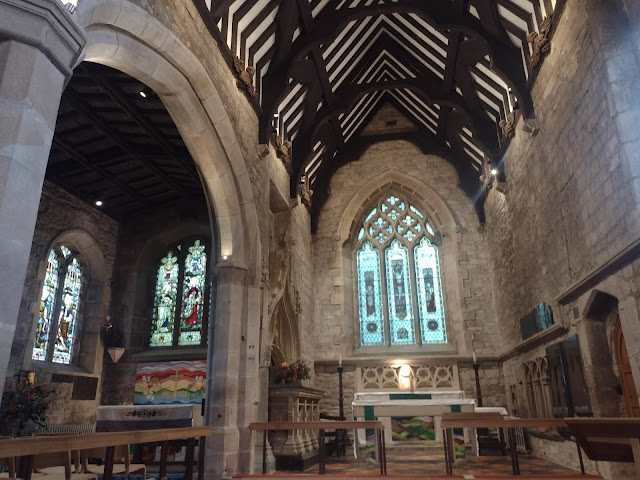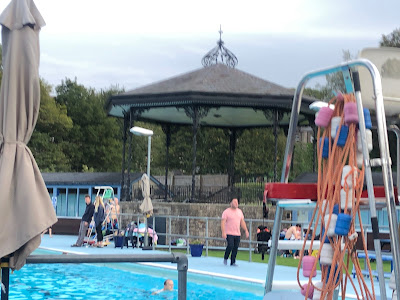 |
The vicarage at the side of St Michael and all Angels church Hathersage. Charlotte would have been the mistress of this house had she married the Reverend Henry Nussey.
|
In early July 1845 Charlotte Bronte, feeling increasingly miserable with the tedium and monotony of her daily life confined to Haworth, had the opportunity to change her scene when she was invited to join her good friend Ellen Nussey at Ellen's brother's vicarage in Hathersage located in the Hope Valley in the Dark Peak of Derbyshire, approximately 11 miles / 18 kms from Sheffield.
I have enjoyed two visits to Hathersage which is truly a delightful village in a stunning setting.
Below are some photos of my Hathersage visits in the footsteps of Charlotte Bronte and her friend Ellen Nussey.
 |
| Hathersage approximately 11 miles from Sheffield. |
Ellen's brother, the Reverend Henry Nussey, who had once proposed to Charlotte in March 1839, but whom she had turned down, had now found himself a wealthy bride, Emily Prescott. They married in Everton, Liverpool in May 1845. Henry, who had been appointed as the vicar of St Michael and All Angels church in Hathersage had extended the vicarage in preparation for his marriage and had asked Ellen to come and supervise the completion of the extension and to refurnish the house before he brought his bride to live there. This was not an easy task as neither Ellen nor Charlotte knew the bride and had no idea what she liked. Nevertheless Charlotte went to join Ellen to assist, allowing herself a three week break from caring for her father Patrick whose eyesight was increasingly worsening. Anne had returned to Haworth unexpectedly, having mysteriously resigned her post at Thorp Green (the reason for this would come out later) and she was now able to care for Patrick allowing Charlotte a much needed break.
Ellen collected Charlotte from the George Inn coaching house in Hathersage after her stage coach arrived from Sheffield and took her to her brother's vicarage. The landlord of the George Inn at the time was named Morton this would be the name Charlotte would give the village of Hathersage where Jane Eyre went to work as a schoolteacher after fleeing from Edward Rochester and Thornfield Hall.
 |
| The George Inn, Hathersage which was the coaching house where Charlotte Bronte's stage coach from Sheffield arrived. |
 |
| The George Inn coaching house where Charlotte Bronte arrived in July 1845 |
 |
The vicarage at the side of St Michael and all Angels church Hathersage.
|
 |
| St Michael and All Angels church and vicarage with wonderful views north towards Stanage Edge. |
The vicarage can be seen to the left with the church directly by it's side in a lovely rural setting. The views of the open countryside from the vicarage are glorious. The church and vicarage stand on a the hill above Hathersage similar to the location of the Bronte parsonage and church at Haworth.
 |
| The vicarage is to the left and the church right next door in a lovely, rural setting. The moors can be seen off to the left. |
 |
| Side view of the vicarage. |
The vicarage with the bay-windowed sitting room and two new bedrooms in the extension added by the Reverend Henry Nussey.
 |
| The vicarage garden. |

 |
| Only 10.75 miles from Hathersage to Sheffield. This grand lamp post was erected in memory of Col. A.J. Shuttleworth a local landowner. |
Charlotte's journey from Sheffield to Hathersage, across rather desolate and flat moorlands, broken only by occasional rocks, must have started her writer's juices flowing, as Jane Eyre would find herself running across this same moorland terrain fleeing from Rochester after the failed wedding ceremony.
 |
| Flat moorland. |
 |
| From the moors above Hathersage looking across the Hope Valley in which the village lies to the hills beyond. Large skies with green pastures and desolate moorland would all influence Charlotte's writing of Jane Eyre. |
Hathersage village and it's environs would go on to have a great influence on Charlotte's writing of Jane Eyre.
Here are some photographs of the village showing properties Charlotte may well have passed by.
 |
| The view of Hathersage descending from the vicarage and church. |
The name Eyre in Charlotte's novel seems to have come from the local wealthy Eyre family who owned North Lees Hall above the village of Hathersage. We enjoyed a wonderful walk to visit it, probably following the same footpath that Charlotte and Ellen would have enjoyed...or so we hoped!
 |
| On the way to North Lees Hall |
 |
| Did Charlotte walk this way, as we did, to visit North Lees Hall? |
We passed a large house called Brookfield Manor. Charlotte looks to have used this as her inspiration for Vale Hall in Jane Eyre. In the novel, Mr Oliver of Vale Hall had made his money from a needle factory and his daughter, Rosamund Oliver funds the village school where Jane teaches under the false name of Jane Elliott. Rosamund pays Jane £30 a year.
 |
Brookfield Manor the inspiration for Vale House in Jane Eyre.
|
Hathersage was famous at that time for successfully manufacturing needles, although the conditions for workers in the 19th century were poor, with the average life expectancy being just 30 years of age.
The postcard below, available to buy from the church, says how North Lees Hall may well have been the inspiration for Thornfield Hall in Jane Eyre. Several houses in England make the same claim, however, the fact that Thorn is North backwards and the word Lee means Field...Thornfield (North Lees) Hall is quite compelling.
Charlotte described Thornfield Hall in Jane Eyre as 'three stories high...a gentleman's manor house...battlements around the top gave it a picturesque look'.
A local legend says that an early mistress of the Hall, Agnes Ashurst, was imprisoned in the attic as a mad woman and died in a fire. |
 |
| A postcard available to purchase in the church. |
 |
| North Lees Hall owned by the Eyre family - built by Robert Eyre in the early 1590s with a further wing added in 1750 after a fire. |
 |
North Lees Hall, two miles to the north of Hathersage.
|
 |
| Charlotte described Thornfield Hall in Jane Eyre as 'three stories high...a gentleman's manor house...battlements around the top gave it a picturesque look'. |
 |
| The Apostles' Cabinet was owned by the Eyre family at North Lees. Charlotte mentioned the cabinet in Jane Eyre. The cabinet can be seen at the Bronte Parsonage museum. It was purchased in 1935 for £30. We can surmise then that Charlotte would have visited the family at North Lees if she writes about this cabinet. |
 |
| An information board shows the location of North Lees Hall in it's glorious setting. With pastures, woodlands and wild moors across a sweeping valley. It's not hard to understand why Charlotte Bronte found inspiration here to write Jane Eyre. |
 |
| Interesting to know the architect of North Lees Hall might also have been the same one who designed magnificent Hardwick Hall. |
 |
| We next headed up the hill, through woodlands with stunning views towards Stanage Edge. |
 |
| Grand views at every turn. |
 |
| Climbing up through woodland towards Stanage Edge. |
 |
| Stanage Edge. |
For any Jane Austen fans, this is the location where Kiera Knightley surveyed the peak in the film as Elizabeth Bennett in Pride and Prejudice.
 |
| Not to be outdone! |




 |
| Stanage Edge with sweeping views over the Hope Valley. |

Then we headed down off Stanage Edge heading for Moorseats Hall. On the wet and boggy, peaty moorlands Jane Eyre collapsed after fleeing Thornfield, being found and rescued by the Reverend St John Rivers.
 |
| Sweeping views coming down from Stanage Edge |
 |
| A photo from an information board showing the moors, rocky outcrops and Stanage Edge. |
 |
| Heading down to Moorseats Hall. |
 |
| Charlotte Bronte created Moor House in her novel Jane Eyre inspired by Moorseats Hall. The Revd St John Rivers lived at Moor House here with his sisters . |

 |
| Standing outside Moorseats Hall on my first visit - the inspiration for Moor House in Jane Eyre home to the Revd John Rivers and his sisters, where Charlotte was nursed back to health, found sanctuary and protection before going on to work as a teacher in Morton /Hathersage. |
 |
| Moorseats Hall / Moor House |
 |
| Moorseats Hall / Moor House now much altered since Charlotte Bronte's visit. |
We then headed back down to Hathersage to visit the church which may date from 1381. By the grand altar, the Eyre family have four fine brasses dating from the 15th century.

 |
| St Michael and All Angels Church |

 |
| In April 1844 Henry Nussey was made curate at St Michael and All Angels Church Hathersage and then he was made vicar in August 1844. |
 |
| The Eyre brass plaques dating from the15th century |
 |
Little John, he of Robin Hood fame, is reputed to be buried in the graveyard in this 14 foot long grave.
If all of the above is not enough for you, there is also a heated open-air swimming pool to enjoy in Hathersage which opened in 1936. |

If you are looking for a good walk in a stunning location, enjoyed not only by my husband and I, but also by Charlotte Bronte, you cannot go wrong spending a day or a weekend in Hathersage.
Charlotte and Ellen also visited the famous caverns along the valley at Castleton where the semi-precious Blue John mineral was mined and made into jewellery and other ornaments. But this will have to be for another blog post.
If you want to follow in Charlotte Bronte's and my footsteps, you can access the details of the walk I followed from this excellent leaflet called the Jane Eyre Hathersage Trail
North Lees Hall was available to rent on Airbnb. The last reviewers were there in November 2023. But all dates are now blocked so I have no idea if one can still rent the hall.
I leave you with a short video showing the stunning scenery we enjoyed on our Hathersage walk.
If you choose to visit Hathersage you will not be disappointed!











































































Great photos, commentary, and the Jane Eyre background!
ReplyDelete